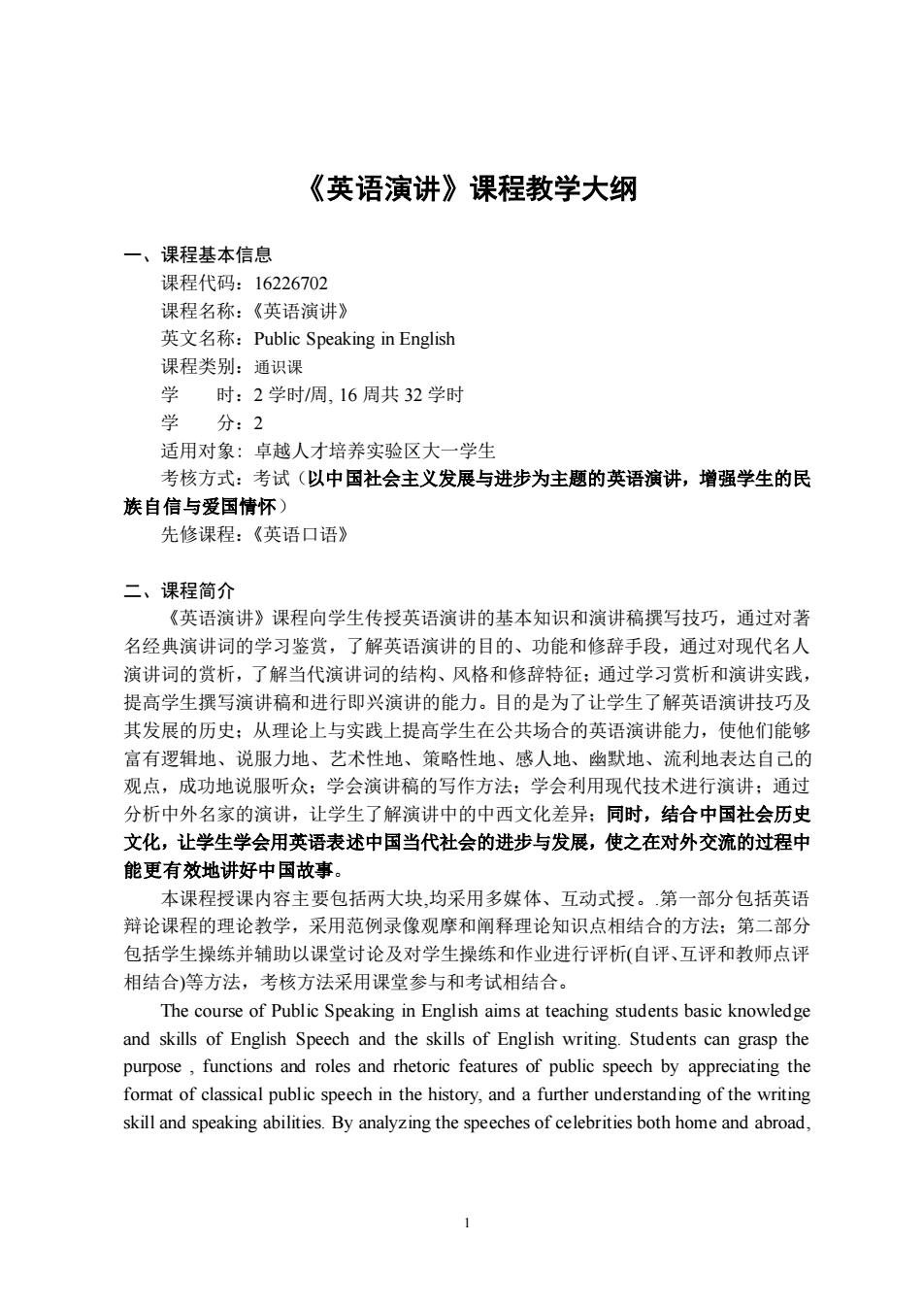
《英语演讲》课程教学大纲 一、课程基本信息 课程代码:16226702 课程名称:《英语演讲》 英文名称:Public Speaking in English 课程类别:通识课 时:2学时/周,16周共32学时 学 分分:2 适用对象:卓越人才培养实验区大一学生 考核方式:考试(以中国社会主义发展与进步为主题的英语演讲,增强学生的民 族自信与爱国情怀) 先修课程:《英语口语》 二、课程简介 《英语演讲》课程向学生传授英语演讲的基本知识和演讲稿撰写技巧,通过对著 名经典演讲词的学习鉴赏,了解英语演讲的目的、功能和修辞手段,通过对现代名人 演讲词的赏析,了解当代演讲词的结构、风格和修辞特征:通过学习赏析和演讲实践, 提高学生耀写演讲稿和讲行即兴演讲的能力。目的是为了让学生了解英语演讲技巧及 其发展的历史:从理论上与实践上提高学生在公共场合的英语演讲能力,使他们能够 宫有罗辑地、说服力地、艺术性地、簧路性地、成人地、幽默地、流利地表达白己的 观点,成功地说服听众:学会演讲稿的写作方法:学会利用现代技术进行演讲:通过 分析中外名家的演讲,让学生了解演讲中的中西文化差异;同时,结合中国社会历史 文化,让学生学会用英语表述中国当代社会的进步与发展,使之在对外交流的过程中 能更有效地讲好中国故事。 本课程授课内容主要包括两大块,均采用多媒体、互动式授。,第一部分包括英语 辩论课程的理论教学,采用范例录像观摩和阐释理论知识点相结合的方法:第二部分 包括学生操练并辅助以课堂讨论及对学生操练和作业进行评析(自评、互评和教师点评 相结合)等方法,考核方法采用课堂参与和考试相结合。 The course of Public Speaking in English aims at teaching students basic knowledge and skills of English Speech and the skills of English writing.Students can grasp the purpose,functions and roles and rhetoric features of public speech by appreciating the format of elassical public speech in the history,and a further understanding of the writing skill and speaking abilities.By analyzing the speeches of celebrities both home and abroad. 1
1 《英语演讲》课程教学大纲 一、课程基本信息 课程代码:16226702 课程名称:《英语演讲》 英文名称:Public Speaking in English 课程类别:通识课 学 时:2 学时/周, 16 周共 32 学时 学 分:2 适用对象: 卓越人才培养实验区大一学生 考核方式:考试(以中国社会主义发展与进步为主题的英语演讲,增强学生的民 族自信与爱国情怀) 先修课程:《英语口语》 二、课程简介 《英语演讲》课程向学生传授英语演讲的基本知识和演讲稿撰写技巧,通过对著 名经典演讲词的学习鉴赏,了解英语演讲的目的、功能和修辞手段,通过对现代名人 演讲词的赏析,了解当代演讲词的结构、风格和修辞特征;通过学习赏析和演讲实践, 提高学生撰写演讲稿和进行即兴演讲的能力。目的是为了让学生了解英语演讲技巧及 其发展的历史;从理论上与实践上提高学生在公共场合的英语演讲能力,使他们能够 富有逻辑地、说服力地、艺术性地、策略性地、感人地、幽默地、流利地表达自己的 观点,成功地说服听众;学会演讲稿的写作方法;学会利用现代技术进行演讲;通过 分析中外名家的演讲,让学生了解演讲中的中西文化差异;同时,结合中国社会历史 文化,让学生学会用英语表述中国当代社会的进步与发展,使之在对外交流的过程中 能更有效地讲好中国故事。 本课程授课内容主要包括两大块,均采用多媒体、互动式授。.第一部分包括英语 辩论课程的理论教学,采用范例录像观摩和阐释理论知识点相结合的方法;第二部分 包括学生操练并辅助以课堂讨论及对学生操练和作业进行评析(自评、互评和教师点评 相结合)等方法,考核方法采用课堂参与和考试相结合。 The course of Public Speaking in English aims at teaching students basic knowledge and skills of English Speech and the skills of English writing. Students can grasp the purpose , functions and roles and rhetoric features of public speech by appreciating the format of classical public speech in the history, and a further understanding of the writing skill and speaking abilities. By analyzing the speeches of celebrities both home and abroad
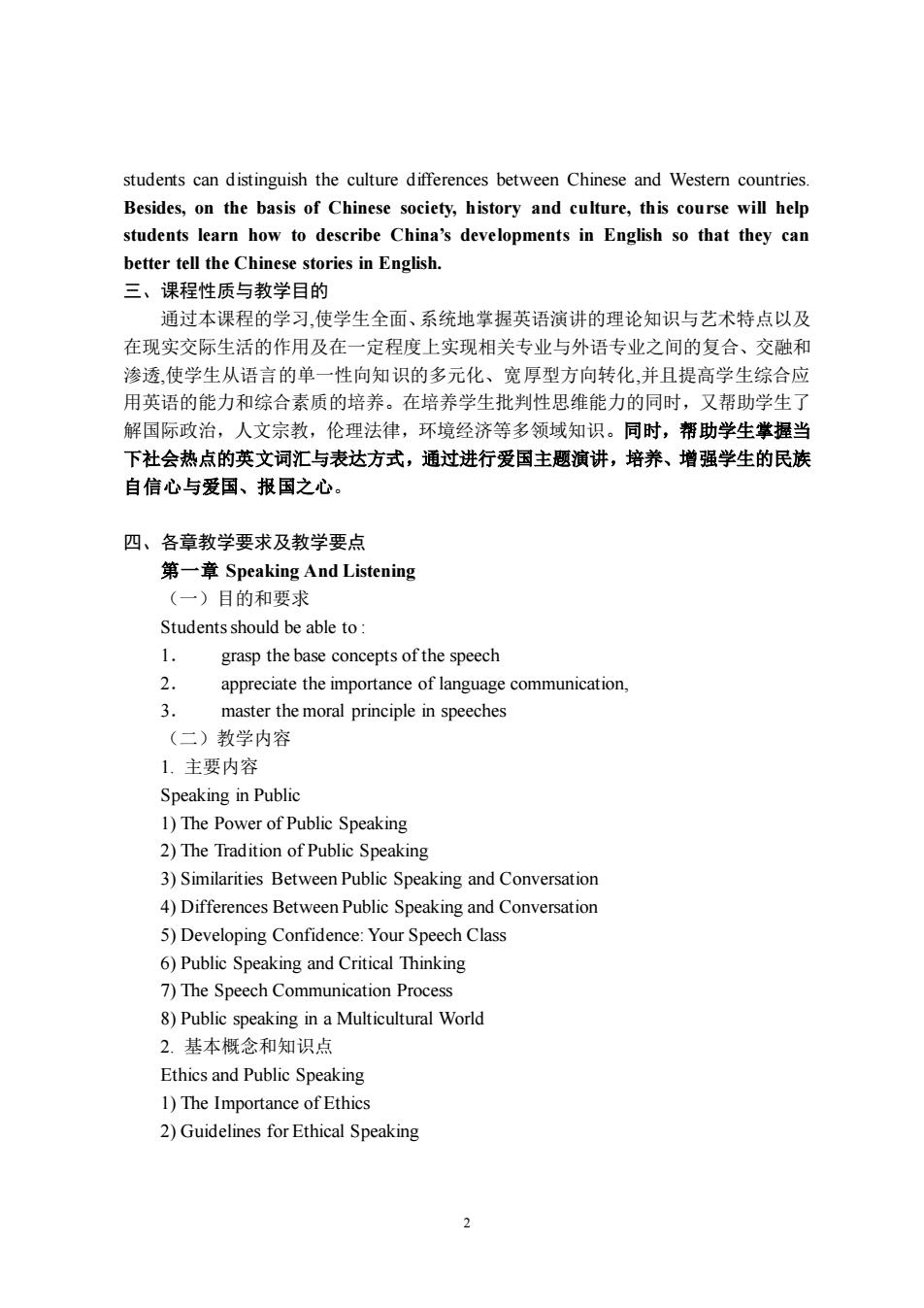
students can distinguish the culture differences between Chinese and Westem countries Besides,on the basis of Chinese society,history and culture,this course will help students learn how to describe China's developments in English so that they can better tell the Chinese stories in English. 三、课程性质与数学目的 通过本课程的学习,使学生全面、系统地掌握英语演讲的理论知识与艺术特点以及 在现实交际生活的作用及在一定程度上实现相关专业与外语专业之间的复合、交融和 渗透,使学生从语言的单一性向知识的多元化、宽厚型方向转化,并且提高学生综合应 用英语的能力和综合素质的培养。在培养学生批判性思维能力的同时,又摆助学生了 解国际政治,人文宗教,伦理法律,环境经济等多领域知识。同时,帮助学生掌握当 下社会热点的英文词汇与表达方式,通过进行爱国主题演讲,培养、增强学生的民族 自信心与爱国、报国之心。 四、各章教学要求及教学要点 第一章Speaking And Listening (一)目的和要求 Students should be able to grasp the base concepts of the speech 2 appreciate the importance of language communication, 3 master the moral principle in speeches (二)教学内容 1.主要内容 Speaking in Public 1)The Power of Public Speaking 2)The Tradition of Public Speaking 3)Similarities Between Public Speaking and Conversation 4)Differences Between Public Speaking and Conversation 5)Developing Confidence:Your Speech Class 6)Public Speaking and Critical Thinking 7)The Speech Communication Process 8)Public speaking in a Multicultural World 2基本概念和知识占 Ethics and Public Speaking 1)The Importance of Ethics 2)Guidelines for Ethical Speaking
2 students can distinguish the culture differences between Chinese and Western countries. Besides, on the basis of Chinese society, history and culture, this course will help students learn how to describe China’s developments in English so that they can better tell the Chinese stories in English. 三、课程性质与教学目的 通过本课程的学习,使学生全面、系统地掌握英语演讲的理论知识与艺术特点以及 在现实交际生活的作用及在一定程度上实现相关专业与外语专业之间的复合、交融和 渗透,使学生从语言的单一性向知识的多元化、宽厚型方向转化,并且提高学生综合应 用英语的能力和综合素质的培养。在培养学生批判性思维能力的同时,又帮助学生了 解国际政治,人文宗教,伦理法律,环境经济等多领域知识。同时,帮助学生掌握当 下社会热点的英文词汇与表达方式,通过进行爱国主题演讲,培养、增强学生的民族 自信心与爱国、报国之心。 四、各章教学要求及教学要点 第一章 Speaking And Listening (一)目的和要求 Students should be able to : 1. grasp the base concepts of the speech 2. appreciate the importance of language communication, 3. master the moral principle in speeches (二)教学内容 1. 主要内容 Speaking in Public 1) The Power of Public Speaking 2) The Tradition of Public Speaking 3) Similarities Between Public Speaking and Conversation 4) Differences Between Public Speaking and Conversation 5) Developing Confidence: Your Speech Class 6) Public Speaking and Critical Thinking 7) The Speech Communication Process 8) Public speaking in a Multicultural World 2. 基本概念和知识点 Ethics and Public Speaking 1) The Importance of Ethics 2) Guidelines for Ethical Speaking
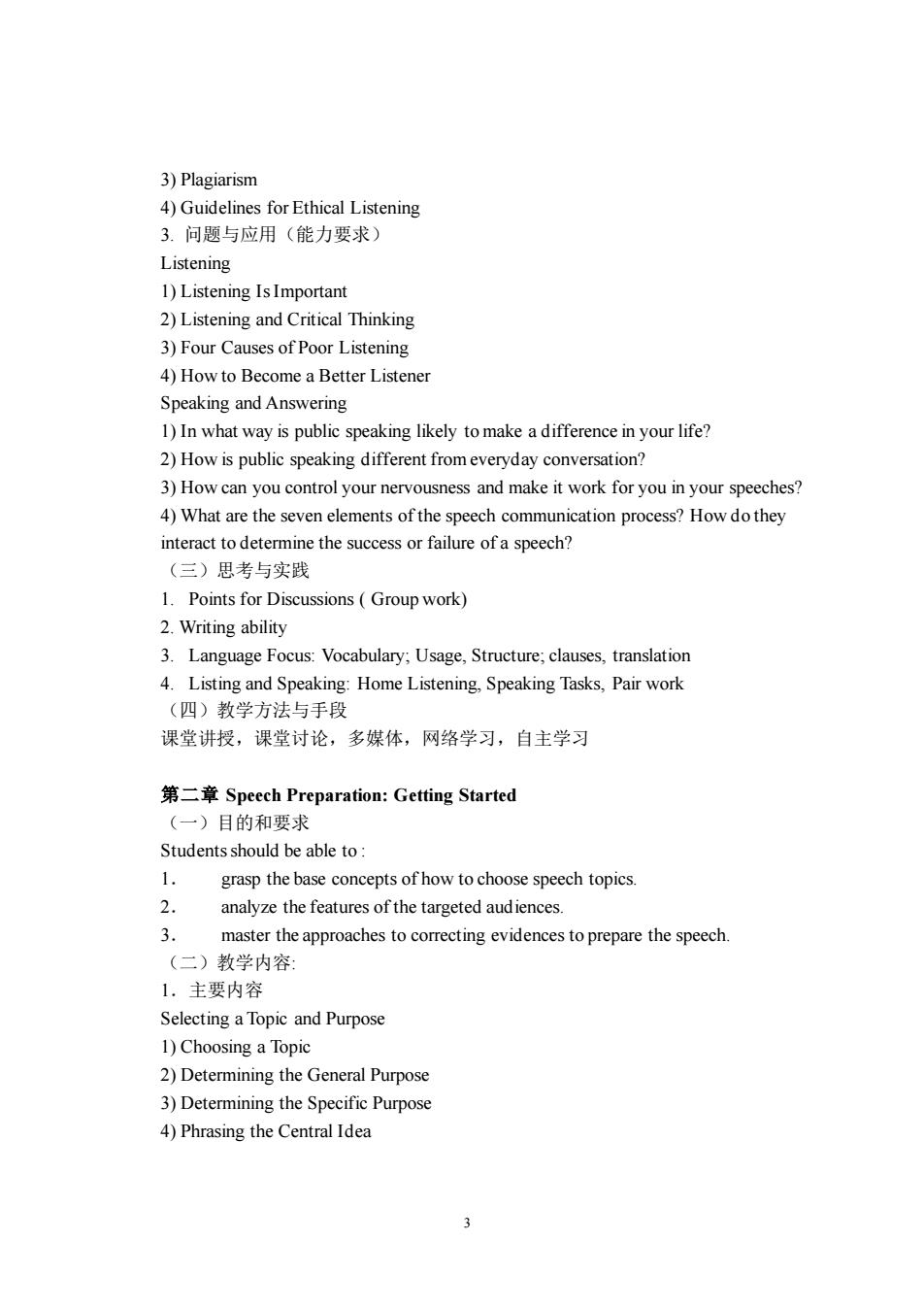
3)Plagiarism 4)Guidelines for Ethical Listening 3.问题与应用(能力要求) Listening 1)Listening IsImportant 2)Listening and Critical Thinking 3)Four Causes of Poor Listening 4)How to Become a Better Listener Speaking and Answering 1)In what way is public speaking likely to make a difference in your life? 2)How is public speaking different fromeveryday conversation? 3)How can you control your nervousness and make it work for you in your speeches? 4)What are the seven elements of the speech communication process?How dothey interact to determine the success or failure of a speech? (三)思考与实践 1.Points for Discussions(Group work) 2.Writing ability 3.Language Focus:Vocabulary:Usage,Structure;clauses,translation 4.Listing and Speaking:Home Listening,Speaking Tasks,Pair work (四)教学方法与手段 课堂讲授,课堂讨论,多媒体,网络学习,自主学习 第二章Speech Preparation:Getting Started (一)目的和要求 Students should be able to grasp the base concepts of how to choose speech topics 2. analyze the features ofthe targeted audiences 3 master the approaches to correcting evidences to prepare the speech. (二)教学内容 1.主要内容 Selecting aTopic and Purpose 1)Choosing a Topic 2)Determining the General Purpose 3)Determining the Specific Purpose 4)Phrasing the Central Idea
3 3) Plagiarism 4) Guidelines for Ethical Listening 3. 问题与应用(能力要求) Listening 1) Listening Is Important 2) Listening and Critical Thinking 3) Four Causes of Poor Listening 4) How to Become a Better Listener Speaking and Answering 1) In what way is public speaking likely to make a difference in your life? 2) How is public speaking different from everyday conversation? 3) How can you control your nervousness and make it work for you in your speeches? 4) What are the seven elements of the speech communication process? How do they interact to determine the success or failure of a speech? (三)思考与实践 1. Points for Discussions ( Group work) 2. Writing ability 3. Language Focus: Vocabulary; Usage, Structure; clauses, translation 4. Listing and Speaking: Home Listening, Speaking Tasks, Pair work (四)教学方法与手段 课堂讲授,课堂讨论,多媒体,网络学习,自主学习 第二章 Speech Preparation: Getting Started (一)目的和要求 Students should be able to : 1. grasp the base concepts of how to choose speech topics. 2. analyze the features of the targeted audiences. 3. master the approaches to correcting evidences to prepare the speech. (二)教学内容: 1.主要内容 Selecting a Topic and Purpose 1) Choosing a Topic 2) Determining the General Purpose 3) Determining the Specific Purpose 4) Phrasing the Central Idea
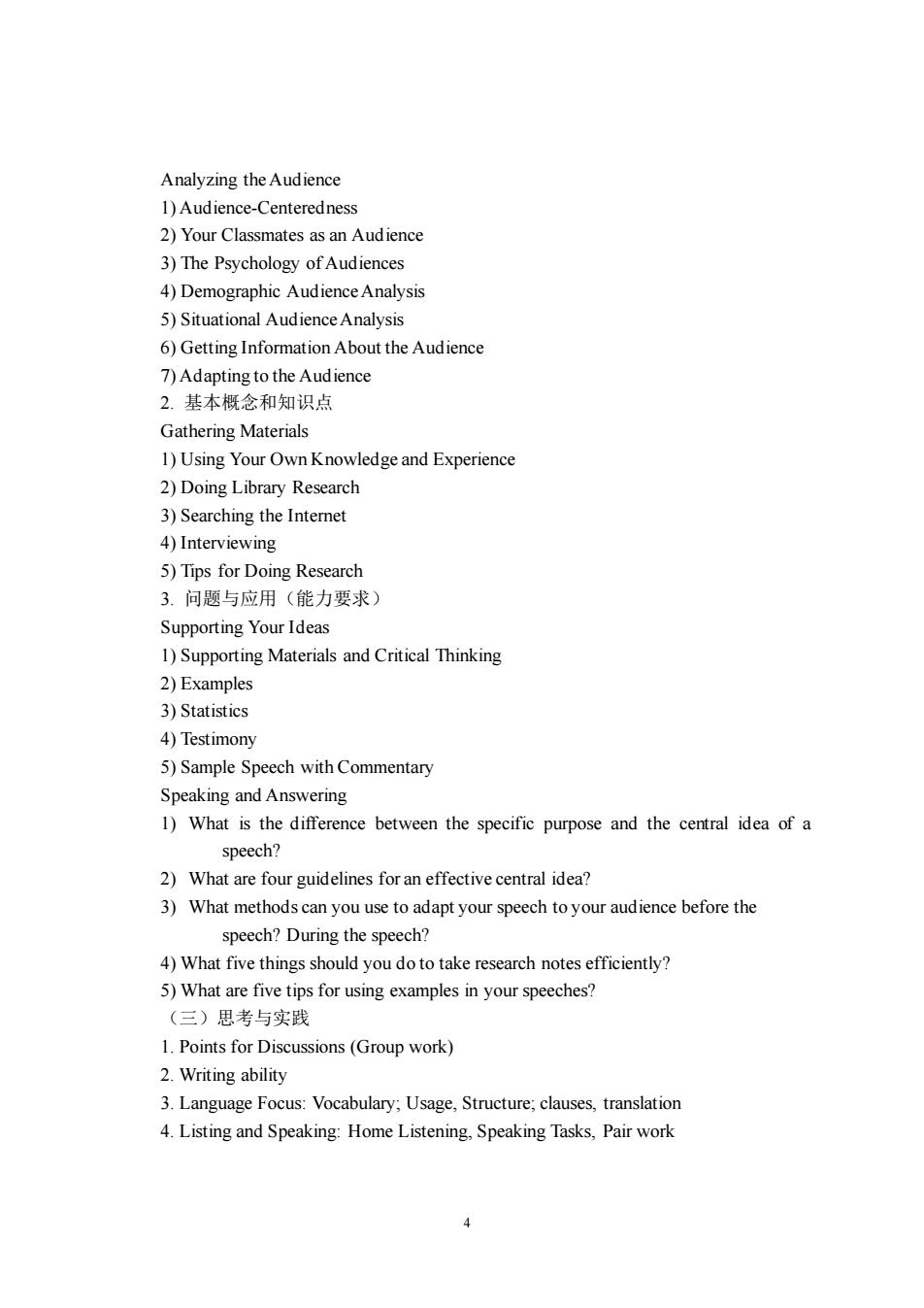
Analyzing the Audience 1)Audience-Centeredness 2)Your Classmates as an audience 3)The Psychology of Audiences 4)Demographic Audience Analysis 5)Situational Audience Analysis 6)Getting Information About the Audience 7)Adapting to the Audience 2基本概念和知识占 Gathering Materials 1)Using Your Own Knowledge and Experience 2)Doing Library Research 3)Searching the Internet 4)Interviewing 5)Tips for Doing Research 3.问题与应用(能力要求) Supporting Your Ideas 1)Supporting Materials and Critical Thinking 2)Examples 3)Statistics 4)Testimony 5)Sample Speech with Commentary Speaking and Answering 1)What is the difference between the specific purpose and the central idea of a speech? 2)What are four guidelines for an effective central idea? 3)What methods can you use to adapt your speech to your audience before the speech?During the speech? 4)What five things should you do to take research notes efficiently? 5)What are five tips for using examples in your speeches? (三)思考与实践 1.Points for Discussions(Group work) 2.Writing ability 3.Language Focus:Vocabulary:Usage.Structure:clauses,translatior 4.Listing and Speaking:Home Listening,Speaking Tasks,Pair work 4
4 Analyzing the Audience 1) Audience-Centeredness 2) Your Classmates as an Audience 3) The Psychology of Audiences 4) Demographic Audience Analysis 5) Situational Audience Analysis 6) Getting Information About the Audience 7) Adapting to the Audience 2. 基本概念和知识点 Gathering Materials 1) Using Your Own Knowledge and Experience 2) Doing Library Research 3) Searching the Internet 4) Interviewing 5) Tips for Doing Research 3. 问题与应用(能力要求) Supporting Your Ideas 1) Supporting Materials and Critical Thinking 2) Examples 3) Statistics 4) Testimony 5) Sample Speech with Commentary Speaking and Answering 1) What is the difference between the specific purpose and the central idea of a speech? 2) What are four guidelines for an effective central idea? 3) What methods can you use to adapt your speech to your audience before the speech? During the speech? 4) What five things should you do to take research notes efficiently? 5) What are five tips for using examples in your speeches? (三)思考与实践 1. Points for Discussions (Group work) 2. Writing ability 3. Language Focus: Vocabulary; Usage, Structure; clauses, translation 4. Listing and Speaking: Home Listening, Speaking Tasks, Pair work
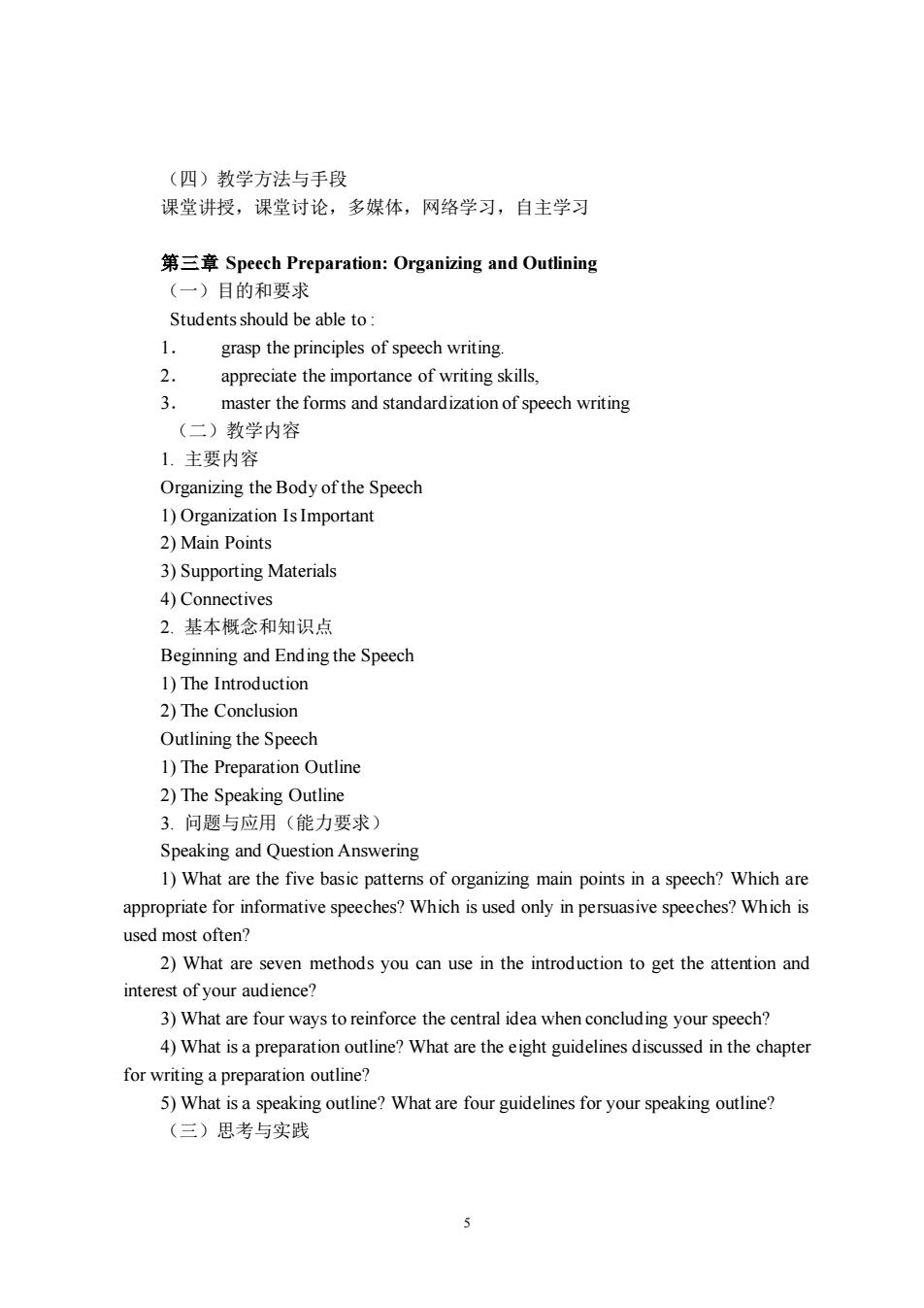
(四)教学方法与手段 课堂讲授,课堂讨论, 多媒体,网络学习,自主学习 第三章Speech Preparation:Organizing and Outlining (一)目的和要求 Studentsshould be able to grasp the principles of speech writing appreciate the importance of writing skills. 3. master the forms and standardization of speech writing (二)教学内容 1.主要内容 Organizing the Body of the Speech 1)Organization Is Important 2)Main Points 3)Supporting Materials 4)Connectives 2.基本概念和知识点 Beginning and Ending the Speech 1)The Introduction 2)The Conclusion Outlining the Speec 1)The Preparation Outline 2)The Speaking Outline 3.问题与应用(能力要求) Speaking and Question Answering 1)What are the five basic patterns of organizing main points in a speech?Which are appropriate for informative speeches?Which is used only in persuasive speeches?Which is used most often? 2)What are seven methods you can use in the introduction to get the attention and interest of your audience? 3)What are four ways to reinforce the central idea when concluding your speech? 4)What is a preparation outline?What are the eight guidelines discussed in the chapter for writing a preparation outline? 5)What is a speaking outline?What are four guidelines for your speaking outline? (三)思考与实践
5 (四)教学方法与手段 课堂讲授,课堂讨论,多媒体,网络学习,自主学习 第三章 Speech Preparation: Organizing and Outlining (一)目的和要求 Students should be able to : 1. grasp the principles of speech writing. 2. appreciate the importance of writing skills, 3. master the forms and standardization of speech writing (二)教学内容 1. 主要内容 Organizing the Body of the Speech 1) Organization Is Important 2) Main Points 3) Supporting Materials 4) Connectives 2. 基本概念和知识点 Beginning and Ending the Speech 1) The Introduction 2) The Conclusion Outlining the Speech 1) The Preparation Outline 2) The Speaking Outline 3. 问题与应用(能力要求) Speaking and Question Answering 1) What are the five basic patterns of organizing main points in a speech? Which are appropriate for informative speeches? Which is used only in persuasive speeches? Which is used most often? 2) What are seven methods you can use in the introduction to get the attention and interest of your audience? 3) What are four ways to reinforce the central idea when concluding your speech? 4) What is a preparation outline? What are the eight guidelines discussed in the chapter for writing a preparation outline? 5) What is a speaking outline? What are four guidelines for your speaking outline? (三)思考与实践
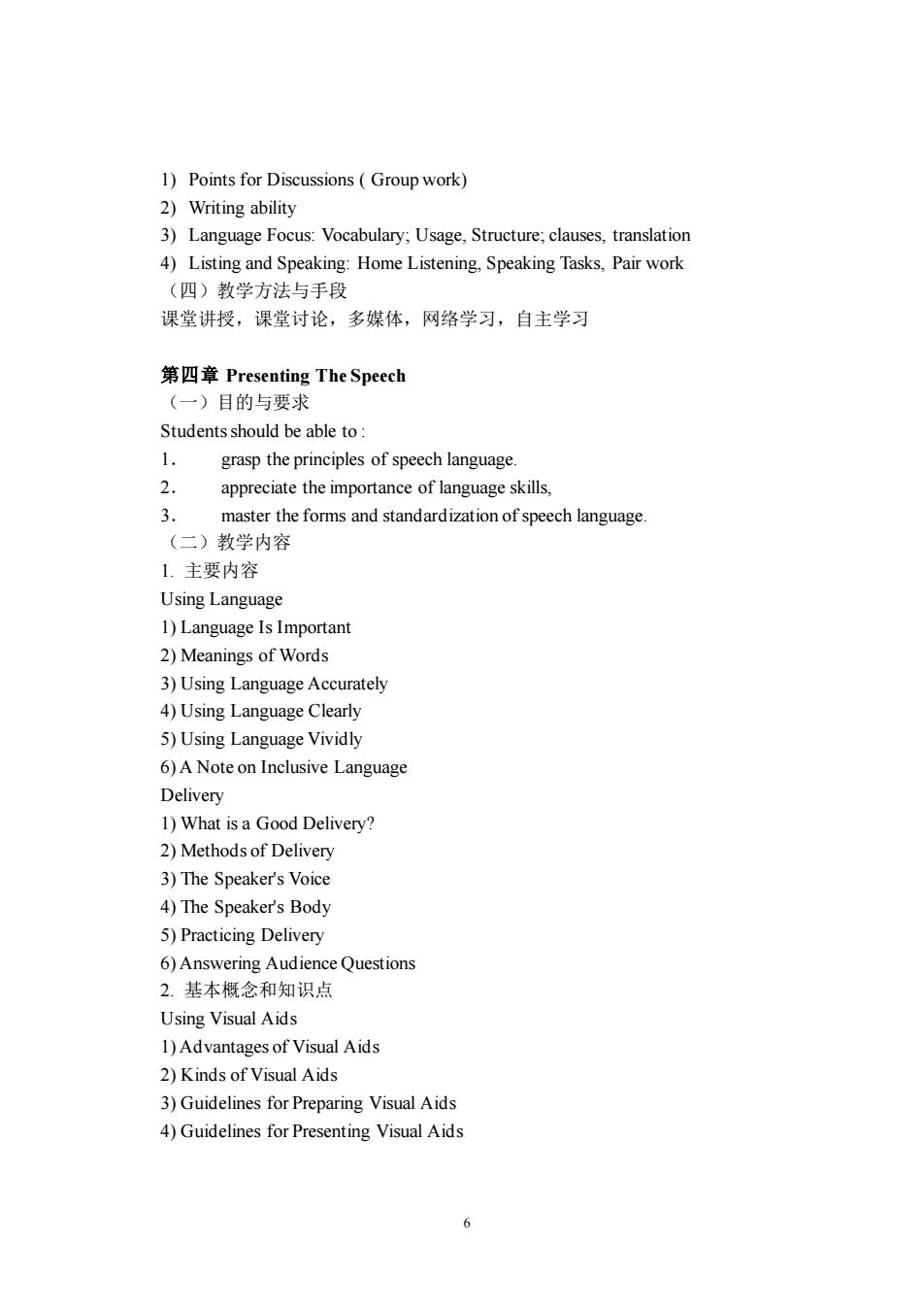
1)Points for Discussions(Group work) 2)Writing ability 3)Language Focus:Vocabulary:Usage,Structure:clauses,translation 4)Listing and Speaking:Home Listening.Speaking Tasks,Pair work (四)教学方法与手段 课堂讲授,课堂讨论,多媒体,网络学习,自主学习 第四章Presenting The Speech (一)目的与要求 Students should be able to: . grasp the principles of speech language 2. appreciate the importance of language skills, 3 master the forms and standardization of speech language (二)教学内容 1.主要内容 Using Language 1)Language Is Important 2)Meanings of Words 3)Using Language Accurately 4)Using Language Clearly 5)Using Language Vividly 6)A Note on Inclusive Language Delivery 1)What is a Good Delivery? 2)Methodsof Delivery 3)The Speaker's Voice 4)The Speaker's Body 5)Practicing Delivery 6)Answering Audience Questions 2.基本概念和知识点 Using Visual Aids 1)Advantages of Visual Aids 2)Kinds of Visual Aids 3)Guidelines for Preparing Visual Aids 4)Guidelines for Presenting Visual Aids 6
6 1) Points for Discussions ( Group work) 2) Writing ability 3) Language Focus: Vocabulary; Usage, Structure; clauses, translation 4) Listing and Speaking: Home Listening, Speaking Tasks, Pair work (四)教学方法与手段 课堂讲授,课堂讨论,多媒体,网络学习,自主学习 第四章 Presenting The Speech (一)目的与要求 Students should be able to : 1. grasp the principles of speech language. 2. appreciate the importance of language skills, 3. master the forms and standardization of speech language. (二)教学内容 1. 主要内容 Using Language 1) Language Is Important 2) Meanings of Words 3) Using Language Accurately 4) Using Language Clearly 5) Using Language Vividly 6) A Note on Inclusive Language Delivery 1) What is a Good Delivery? 2) Methods of Delivery 3) The Speaker's Voice 4) The Speaker's Body 5) Practicing Delivery 6) Answering Audience Questions 2. 基本概念和知识点 Using Visual Aids 1) Advantages of Visual Aids 2) Kinds of Visual Aids 3) Guidelines for Preparing Visual Aids 4) Guidelines for Presenting Visual Aids
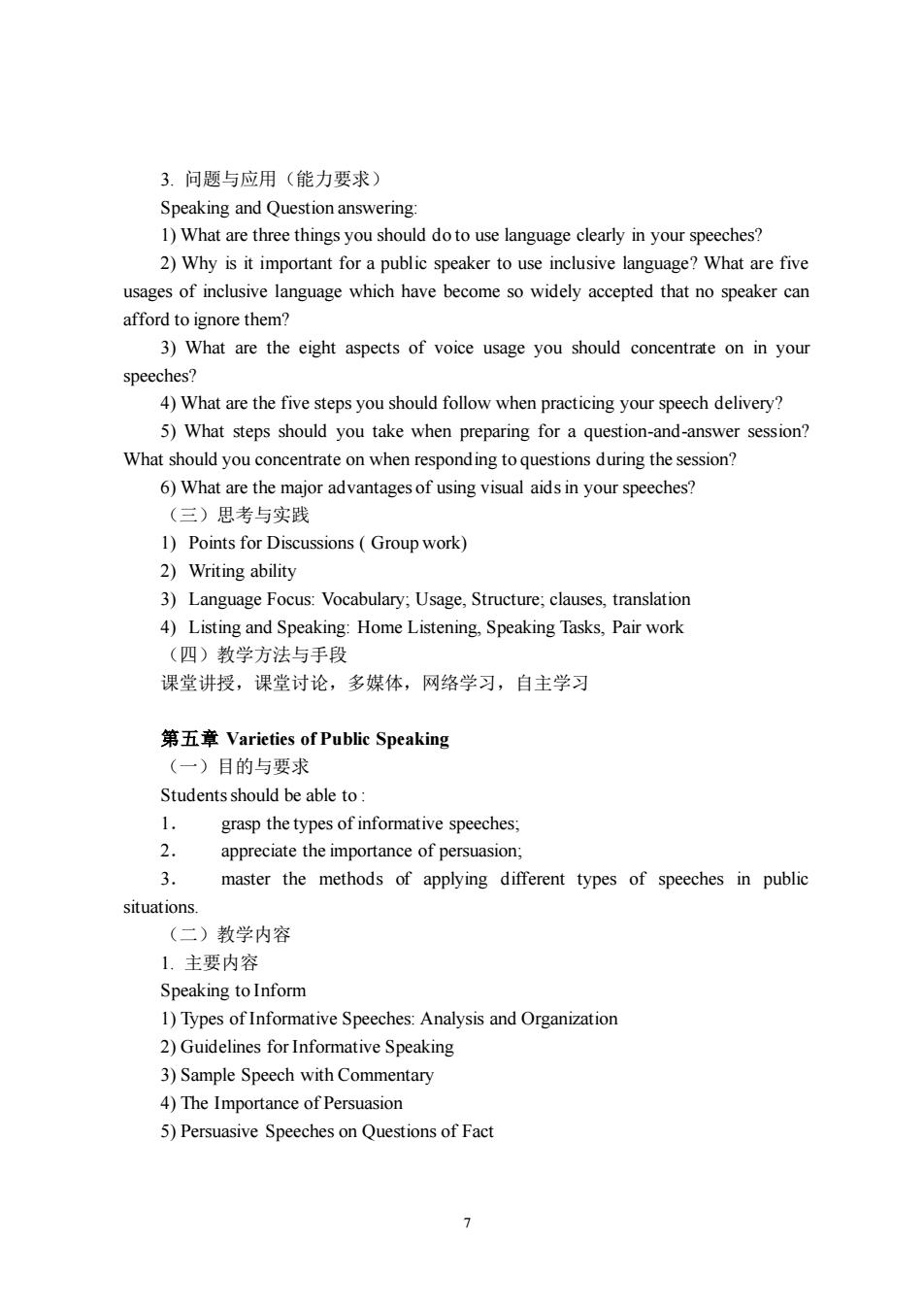
3.问题与应用(能力要求) Speaking and Question answering 1)What are three things you should do to use language clearly in your speeches? 2)Why is it important for a public speaker to use inclusive language?What are five usages of inclusive language which have become so widely accepted that no speaker can afford to ignore them? 3)What are the eight aspects of voice usage you should concentrate on in your speeches? 4)What are the five steps you should follow when practicing your speech delivery? 5)What steps should you take when preparing for a question-and-answer session? What should you concentrate on when responding to questions during the session? 6)What are the major advantages of using visual aids in your speeches? (三)思考与实践 1)Points for Discussions(Group work) 2)Writing ability 3)Language Focus:Vocabulary;Usage,Structure,clauses,translation 4)Listing and Speaking:Home Listening.Speaking Tasks.Pair work (四)教学方法与手段 课堂讲授,课堂讨论,多媒体,网络学习,自主学习 第五章Varieties of Public Speaking (一)目的与要求 Students should be able to 1. grasp the types of informative speeches: 2. appreciate the importance of persuasion; 3. master the methods of applying different types of speeches in public situations. (二)教学内容 1.主要内容 Speaking to Inform 1)Types of Informative Speeches:Analysis and Organization 2)Guidelines for Informative Speaking 3)Sample Speech with Commentary 4)The Importance of Persuasion 5)Persuasive Speeches on Questions of Fact 7
7 3. 问题与应用(能力要求) Speaking and Question answering: 1) What are three things you should do to use language clearly in your speeches? 2) Why is it important for a public speaker to use inclusive language? What are five usages of inclusive language which have become so widely accepted that no speaker can afford to ignore them? 3) What are the eight aspects of voice usage you should concentrate on in your speeches? 4) What are the five steps you should follow when practicing your speech delivery? 5) What steps should you take when preparing for a question-and-answer session? What should you concentrate on when responding to questions during the session? 6) What are the major advantages of using visual aids in your speeches? (三)思考与实践 1) Points for Discussions ( Group work) 2) Writing ability 3) Language Focus: Vocabulary; Usage, Structure; clauses, translation 4) Listing and Speaking: Home Listening, Speaking Tasks, Pair work (四)教学方法与手段 课堂讲授,课堂讨论,多媒体,网络学习,自主学习 第五章 Varieties of Public Speaking (一)目的与要求 Students should be able to : 1. grasp the types of informative speeches; 2. appreciate the importance of persuasion; 3. master the methods of applying different types of speeches in public situations. (二)教学内容 1. 主要内容 Speaking to Inform 1) Types of Informative Speeches: Analysis and Organization 2) Guidelines for Informative Speaking 3) Sample Speech with Commentary 4) The Importance of Persuasion 5) Persuasive Speeches on Questions of Fact
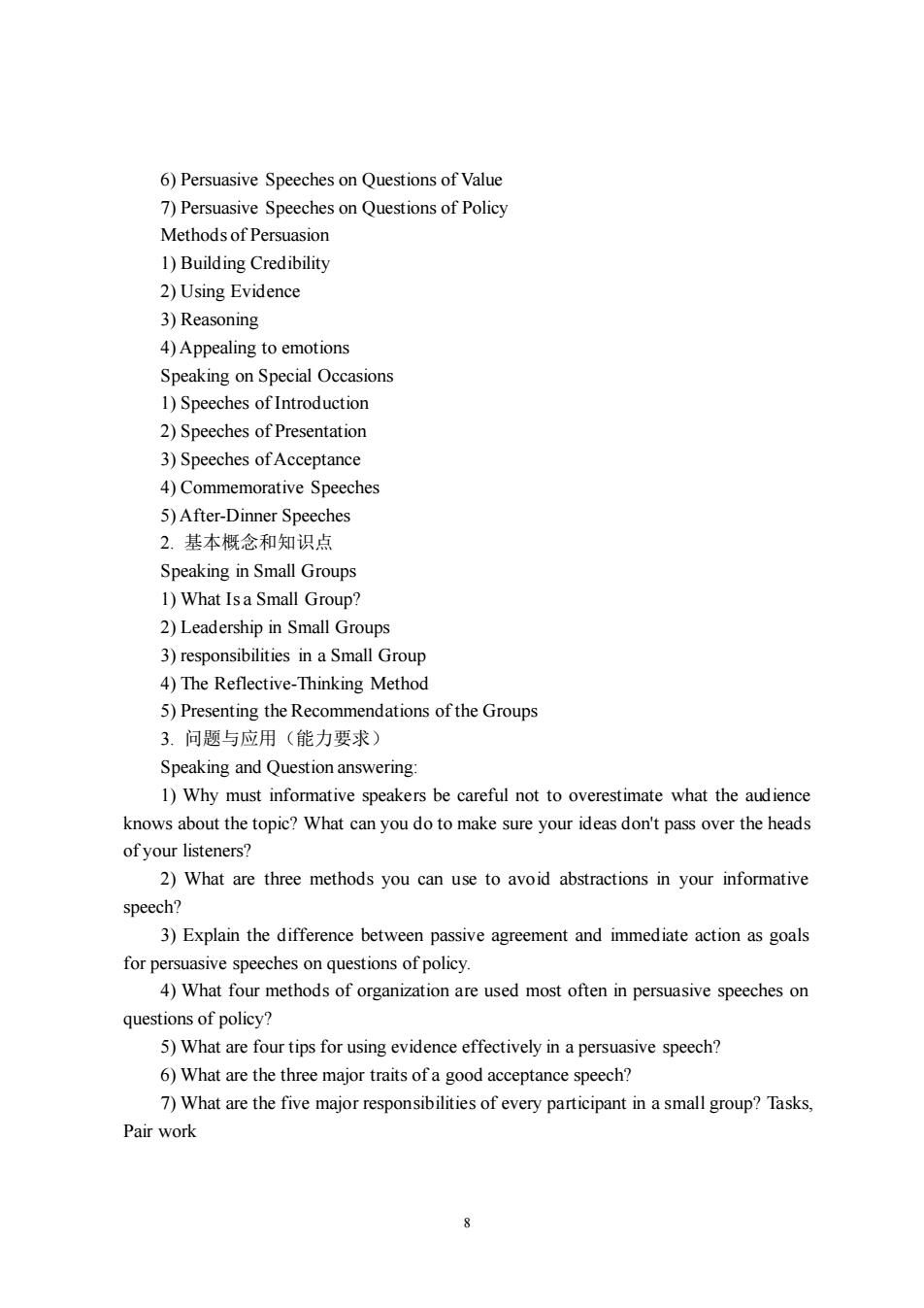
6)Persuasive Speeches on Questions of Value 7)Persuasive Speeches on Questions of Policy Methods of Persuasion 1)Building Credibility 2)Using evidence 3)Reasoning 4)Appealing to emotions Speaking on Special Occasions 1)Speeches ofIntroduction 2)Speeches of Presentation 3)Speeches ofAcceptance 4)Commemorative Speeches 5)After-Dinne Speeches 2.基本概念和知识点 Speaking in Small Groups 1)What Isa Small Group? 2)Leadership in Small Groups 3)responsibilities in a Small Group 4)The Reflective-Thinking Method 5)Presenting the Recommendations of the Groups 3.问题与应用(能力要求) Speaking and Ouestion answering 1)Why must informative speakers be careful not to overestimate what the audience knows about the topic?What can you do to make sure your ideas don't pass over the heads ofyour listeners? 2)What are three methods you can use to avoid abstractions in your informative speech? 3)Explain the difference between passive agreement and immediate action as goals for persuasive speeches on questions of policy. 4)What four methods of organization are used most often in persuasive speeches on questions of policy? 5)What are four tips for using evidence effectively in a persuasive speech? 6)What are the three major traits ofa good acceptance speech? 7)What are the five major responsibilities of every participant in a small group?Tasks Pair work
8 6) Persuasive Speeches on Questions of Value 7) Persuasive Speeches on Questions of Policy Methods of Persuasion 1) Building Credibility 2) Using Evidence 3) Reasoning 4) Appealing to emotions Speaking on Special Occasions 1) Speeches of Introduction 2) Speeches of Presentation 3) Speeches of Acceptance 4) Commemorative Speeches 5) After-Dinner Speeches 2. 基本概念和知识点 Speaking in Small Groups 1) What Is a Small Group? 2) Leadership in Small Groups 3) responsibilities in a Small Group 4) The Reflective-Thinking Method 5) Presenting the Recommendations of the Groups 3. 问题与应用(能力要求) Speaking and Question answering: 1) Why must informative speakers be careful not to overestimate what the audience knows about the topic? What can you do to make sure your ideas don't pass over the heads of your listeners? 2) What are three methods you can use to avoid abstractions in your informative speech? 3) Explain the difference between passive agreement and immediate action as goals for persuasive speeches on questions of policy. 4) What four methods of organization are used most often in persuasive speeches on questions of policy? 5) What are four tips for using evidence effectively in a persuasive speech? 6) What are the three major traits of a good acceptance speech? 7) What are the five major responsibilities of every participant in a small group? Tasks, Pair work
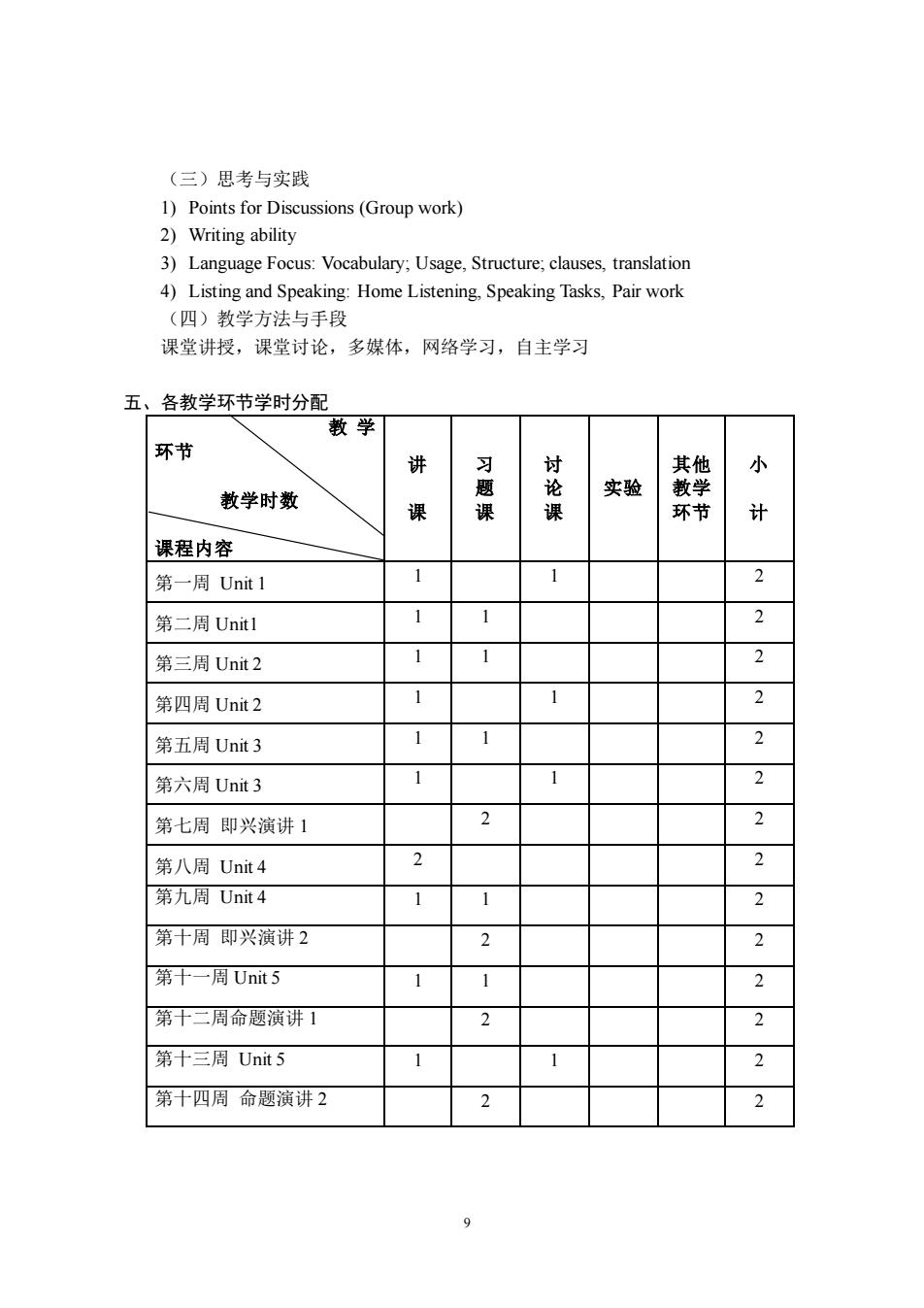
(三)思考与实践 1)Points for Discussions(Group work) 2)Writing ability 3)Language Focus:Vocabulary:Usage.Structure.clauses,translation 4)Listing and Speaking:Home Listening.Speaking Tasks,Pair work (四)教学方法与手段 课堂讲授,课堂讨论,多媒体,网络学习,自主学习 五、各教学环节学时分配 教学 环节 必 其他 小 教学时数 题 实验 教 环节 课程内容 第一周Unit1 第二周Unit1 第三周Unit2 2 第四周Unit2 2 第五周Unit3 2 第六周Unit3 2 第七周即兴演讲1 2 第八周Unit4 2 2 第九周Unit4 第十周即兴演讲2 2 第十一周Unit5 第十二周命题演讲1 第十三周Unit5 第十四周命题演讲2
9 (三)思考与实践 1) Points for Discussions (Group work) 2) Writing ability 3) Language Focus: Vocabulary; Usage, Structure; clauses, translation 4) Listing and Speaking: Home Listening, Speaking Tasks, Pair work (四)教学方法与手段 课堂讲授,课堂讨论,多媒体,网络学习,自主学习 五、各教学环节学时分配 教 学 环节 教学时数 课程内容 讲 课 习 题 课 讨 论 课 实验 其他 教学 环节 小 计 第一周 Unit 1 1 1 2 第二周 Unit1 1 1 2 第三周 Unit 2 1 1 2 第四周 Unit 2 1 1 2 第五周 Unit 3 1 1 2 第六周 Unit 3 1 1 2 第七周 即兴演讲 1 2 2 第八周 Unit 4 2 2 第九周 Unit 4 1 1 2 第十周 即兴演讲 2 2 2 第十一周 Unit 5 1 1 2 第十二周命题演讲 1 2 2 第十三周 Unit 5 1 1 2 第十四周 命题演讲 2 2 2
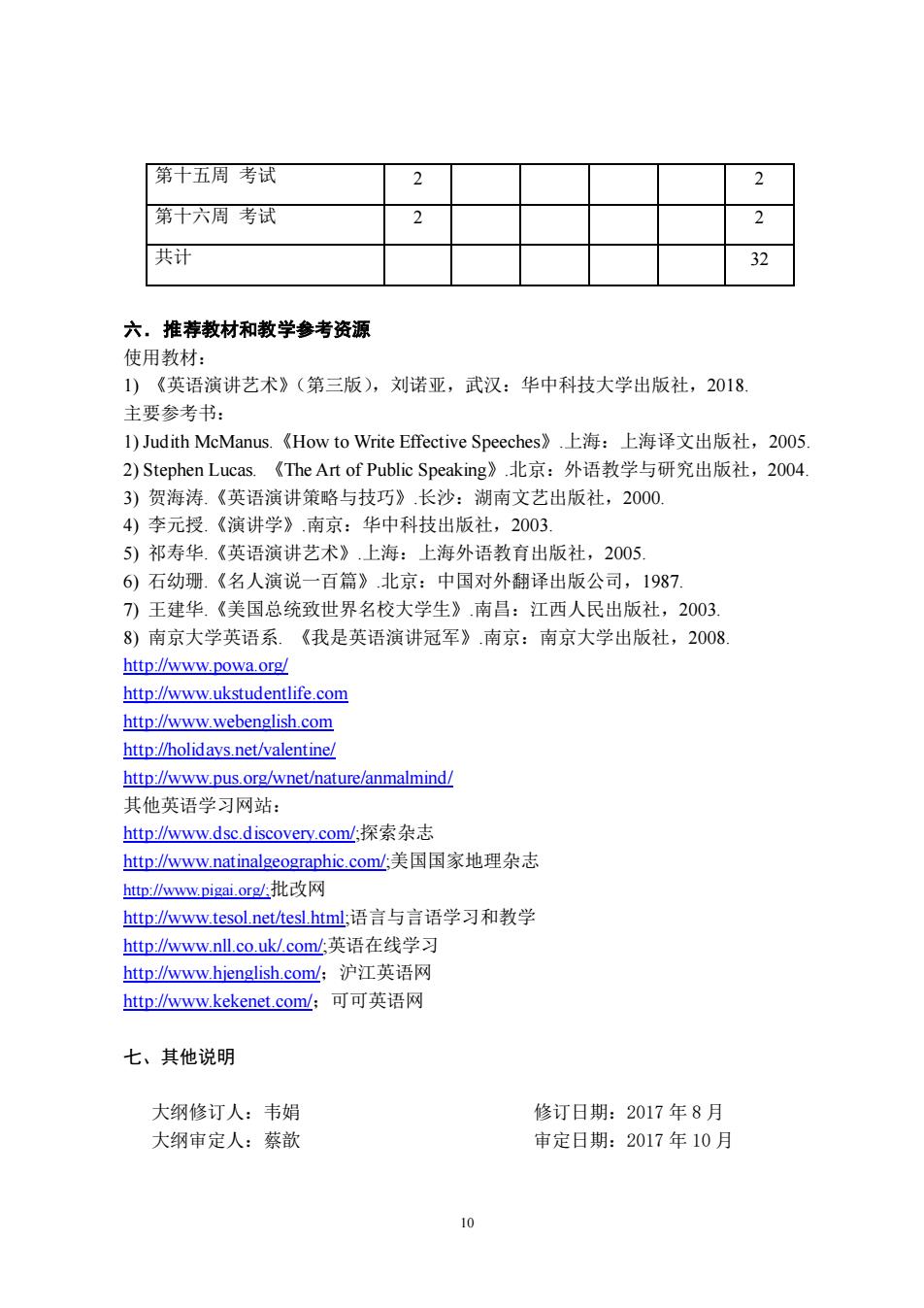
第十五周考试 2 第十六周考试 2 共计 32 六.推荐教材和教学参考资源 使用教材: 1)《英语演讲艺术》(第三版),刘诺亚,武汉:华中科技大学出版社,2018. 主要参考书: 1)Judith MeManus..《How to Write Effective Speeches》.上海:上海译文出版社,2OO5 2)Stephen Lucas..《The Art of Public Speaking?》.北京:外语教学与研究出版社,2004. 3)贺海涛.《英语演讲策略与技巧》长沙:湖南文艺出版社,2000, 4)李元授.《演讲学》南京:华中科技出版社,2003. 5)祁寿华.《英语演讲艺术》.上海:上海外语教育出版社,2005. 6)石幼珊.《名人演说一百篇》北京:中国对外翻译出版公司,1987 7)王建华.《美国总统致世界名校大学生》南昌:江西人民出版社,2003. 8)南京大学英语系.《我是英语演讲冠军》南京:南京大学出版社,2008 http://www.powa.org/ http://www.ukstudentlife.com http://www.webenglish.com http://holidavs net/valentine/ http://www.pus.org/wnet/nature/anmalmind/ 其他英语学习网站: http://www.dse discovery.com探索杂志 http://www.natinalgeographic.com美国国家地理杂志 http://www.pigai.org过批改网 http://www.tesol net/tesl html语言与言语学习和教学 http://www.nll..co.uk/com止英语在线学习 http://www.hienglish.com:沪江英语网 httD://www kekenet com/:可可英i语网 七、其他说明 大纲修订人:韦娟 修订日期:2017年8月 大纲审定人:蔡歆 审定日期:2017年10月 10
10 第十五周 考试 2 2 第十六周 考试 2 2 共计 32 六.推荐教材和教学参考资源 使用教材: 1) 《英语演讲艺术》(第三版),刘诺亚,武汉:华中科技大学出版社,2018. 主要参考书: 1) Judith McManus.《How to Write Effective Speeches》.上海:上海译文出版社,2005. 2) Stephen Lucas. 《The Art of Public Speaking》.北京:外语教学与研究出版社,2004. 3) 贺海涛.《英语演讲策略与技巧》.长沙:湖南文艺出版社,2000. 4) 李元授.《演讲学》.南京:华中科技出版社,2003. 5) 祁寿华.《英语演讲艺术》.上海:上海外语教育出版社,2005. 6) 石幼珊.《名人演说一百篇》.北京:中国对外翻译出版公司,1987. 7) 王建华.《美国总统致世界名校大学生》.南昌:江西人民出版社,2003. 8) 南京大学英语系. 《我是英语演讲冠军》.南京:南京大学出版社,2008. http://www.powa.org/ http://www.ukstudentlife.com http://www.webenglish.com http://holidays.net/valentine/ http://www.pus.org/wnet/nature/anmalmind/ 其他英语学习网站: http://www.dsc.discovery.com/;探索杂志 http://www.natinalgeographic.com/;美国国家地理杂志 http://www.pigai.org/;批改网 http://www.tesol.net/tesl.html;语言与言语学习和教学 http://www.nll.co.uk/.com/;英语在线学习 http://www.hjenglish.com/;沪江英语网 http://www.kekenet.com/;可可英语网 七、其他说明 大纲修订人:韦娟 修订日期:2017 年 8 月 大纲审定人:蔡歆 审定日期:2017 年 10 月